Production and Properties of High Entropy Carbide Based Hardmetals
Abstract
1. Introduction
2. Materials and Methods
2.1. Preparation of HEC Powders
2.2. Preparation of HEC-Co Hardmetals
3. Results and Discussion
3.1. Synthesis of HEC Powders
3.2. Properties of HEC-Co Hardmetals
3.3. Physical and Mechanical Properties of HEC-Co Hardmetals
4. Conclusions and Outlook
Author Contributions
Funding
Institutional Review Board Statement
Informed Consent Statement
Acknowledgments
Conflicts of Interest
References
- Antonov, M.; Hussainova, P. Chromium carbide based cermets as the wear resistant materials. In Proceedings of the 4th International Conference Industrial Engineeringinnovation as Competitive Edge for SME, Tallinn, Estonia, 29–30 April 2004; pp. 169–172. [Google Scholar]
- Huang, S.G.; van der Biest, O.; Li, L.; Vleugels, J. Properties of NbC–Co cermets obtained by spark plasma sintering. Mater. Lett. 2007, 61, 574–577. [Google Scholar] [CrossRef]
- Huang, S.G.; Vanmeensel, K.; Mohrbacher, H.; Woydt, M.; Vleugels, J. Microstructure and mechanical properties of NbC-matrix hardmetals with secondary carbide addition and different metal binders. Int. J. Refract. Met. Hard Mater. 2015, 48, 418–426. [Google Scholar] [CrossRef]
- Huang, S.G.; Vleugels, J.; Mohrbacher, H.; Woydt, M. NbC grain growth control and mechanical properties of Ni bonded NbC cermets prepared by vacuum liquid phase sintering. Int. J. Refract. Met. Hard Mater. 2018, 72, 63–70. [Google Scholar] [CrossRef]
- Montenegro, P.; Gomes, J.; Rego, R.; Borille, A. Potential of niobium carbide application as the hard phase in cutting tool substrate. Int. J. Refract. Met. Hard Mater. 2018, 70, 116–123. [Google Scholar] [CrossRef]
- Pötschke, J.; Richter, V.; Mayer, M. Manufacturing and properties of polycrystalline WC-Co based cemented carbides. In Proceedings of the 2016 International Conference on Powder Metallurgy & Particulate Materials, MPIF, Boston, MA, USA, 5–8 June 2016; pp. 457–466. [Google Scholar]
- Ettmayer, P. Hardmetals and Cermets. Annu. Rev. Maler. Sci. 1989, 19, 145–164. [Google Scholar] [CrossRef]
- Hummer, J. WC-CrC-Co Sintered Composite. Patent No. US3480410A, 15 May 1968. [Google Scholar]
- Hashe, N.G.; Norgren, S.M.; Andrén, H.-O.; Neethling, J.H. Characterization of WC–(W,V)C–Co made from pre-alloyed (W,V)C. Int. J. Refract. Met. Hard Mater. 2009, 27, 229–233. [Google Scholar] [CrossRef]
- Holleck, H.; Thümmler, F. Eigenschaften von (Ta. Mo)- und (Ta. W)-Mischcarbiden und deren Verhalten zu Bindemetallen. Plansee Semin. 1975, 23, 175–185. [Google Scholar]
- Kieffer, R.; Trabesinger, G.; Reiter, N. Über NbC- und HfC-haltige Hartstoffe und Hartmetalle. Plansee Semin. 1969, 17, 25–35. [Google Scholar]
- Exner, H. Physical and chemical nature of cemented carbides. Int. Met. Rev. 1979, 4, 149–173. [Google Scholar]
- Norgren, S.; García, J.; Blomquist, A.; Yin, L. Trends in the P/M hard metal industry. Int. J. Refract. Met. Hard Mater. 2015, 48, 31–45. [Google Scholar] [CrossRef]
- Ettmayer, P.; Kolaska, H. Cermets der neuen Generation. Metall 1989, 43, 742–749. [Google Scholar]
- Lengauer, W.; Chen, L.; Gracia, J.; Ucakar, V.; Drezer, K.; Kassel, D.; Daub, H.W. Diffusion controlled surface modification for fabrication of functional gradient (Ti W)C based cemented carbonitrides. Euro Powder Metall. 1999, 3, 475–482. [Google Scholar]
- Komac, M.; Kos, K.; Novak, S. Hard Metals Based on Titanium and Molybdenum Carbides. Inst. Mater. Festkörp. 1983, 15, 76–85. [Google Scholar]
- Ettmayer, P.; Kolaska, H.; Lengauer, W.; Dreyer, K. Ti(C,N) cermets—Metallurgy and properties. Int. J. Refract. Met. Hard Mater. 1995, 13, 343–351. [Google Scholar] [CrossRef]
- Lengauer, W.; Binder, S.; Aigner, K.; Ettmayer, P.; Guillou, A.; Debuigne, J.; Groboth, G. Solid state properties of group IVb carbonitrides. J. Alloy. Compd. 1995, 217, 137–147. [Google Scholar] [CrossRef]
- Agnew, S.R.; Dong, L.; Keene, J.I.; Wadley, H.N.G. Mechanical properties of large TiC-Mo-Ni cermet tiles. Int. J. Refract. Met. Hard Mater. 2018, 75, 238–247. [Google Scholar] [CrossRef]
- Chen, X.; Xiong, W.; Qu, J.; Yang, Q.; Yao, Z.; Huang, Y. Microstructure and mechanical properties of (Ti,W,Ta)C-xMo-Ni cermets. Int. J. Refract. Met. Hard Mater. 2012, 31, 56–61. [Google Scholar] [CrossRef]
- Csanádi, T.; Castle, E.; Reece, M.J.; Dusza, J. Strength enhancement and slip behaviour of high-entropy carbide grains during micro-compression. Sci. Rep. 2019, 9, 10200. [Google Scholar] [CrossRef]
- Andrén, H.-O. Microstructures of cemented carbides. Mater. Des. 2001, 22, 491–498. [Google Scholar] [CrossRef]
- Holmström, E.; Lizárraga, R.; Linder, D.; Salmasi, A.; Wang, W.; Kaplan, B.; Mao, H.; Larsson, H.; Vitos, L. High entropy alloys: Substituting for cobalt in cutting edge technology. Appl. Mater. Today 2018, 12, 322–329. [Google Scholar] [CrossRef]
- De La Obra, A.G.; Avilés, M.A.; Torres, Y.; Chicardi, E.; Gotor, F.J. A new family of cermets: Chemically complex but microstructurally simple. Int. J. Refract. Met. Hard Mater. 2017, 63, 17–25. [Google Scholar] [CrossRef]
- Yan, X.; Constantin, L.; Lu, Y.; Silvain, J.-F.; Nastasi, M.; Cui, B. (Hf 0.2 Zr 0.2 Ta 0.2 Nb 0.2 Ti 0.2 )C high-entropy ceramics with low thermal conductivity. J. Am. Ceram. Soc. 2018, 101, 4486–4491. [Google Scholar] [CrossRef]
- Castle, E.; Csanádi, T.; Grasso, S.; Dusza, J.; Reece, M. Processing and Properties of High-Entropy Ultra-High Temperature Carbides. Sci. Rep. 2018, 8, 8609. [Google Scholar] [CrossRef]
- Harrington, T.J.; Gild, J.; Sarker, P.; Toher, C.; Rost, C.M.; Dippo, O.F.; McElfresh, C.; Kaufmann, K.; Marin, E.; Borowski, L.; et al. Phase stability and mechanical properties of novel high entropy transition metal carbides. Acta Mater. 2019, 166, 271–280. [Google Scholar] [CrossRef]
- Feng, L.; Fahrenholtz, W.G.; Hilmas, G.E. Low-temperature sintering of single-phase, high-entropy carbide ceramics. J. Am. Ceram. Soc. 2019, 102, 7217–7224. [Google Scholar] [CrossRef]
- Lu, K.; Liu, J.-X.; Wei, X.-F.; Bao, W.; Wu, Y.; Li, F.; Xu, F.; Zhang, G.-J. Microstructures and mechanical properties of high-entropy (Ti0.2Zr0.2Hf0.2Nb0.2Ta0.2)C ceramics with the addition of SiC secondary phase. J. Eur. Ceram. Soc. 2020, 40, 1839–1847. [Google Scholar] [CrossRef]
- Wei, X.-F.; Liu, J.-X.; Li, F.; Qin, Y.; Liang, Y.-C.; Zhang, G.-J. High entropy carbide ceramics from different starting materials. J. Eur. Ceram. Soc. 2019, 39, 2989–2994. [Google Scholar] [CrossRef]
- Ye, B.; Wen, T.; Nguyen, M.C.; Hao, L.; Wang, C.-Z.; Chu, Y. First-principles study, fabrication and characterization of (Zr0.25Nb0.25Ti0.25V0.25)C high-entropy ceramics. Acta Mater. 2019, 170, 15–23. [Google Scholar] [CrossRef]
- Bao, W.; Wang, X.-G.; Ding, H.; Lu, P.; Zhu, C.; Zhang, G.-J.; Xu, F. High-entropy M2AlC-MC (M=Ti, Zr, Hf, Nb, Ta) composite: Synthesis and microstructures. Scr. Mater. 2020, 183, 33–38. [Google Scholar] [CrossRef]
- Wang, K.; Chen, L.; Xu, C.; Zhang, W.; Liu, Z.; Wang, Y.; Ouyang, J.; Zhang, X.; Fu, Y.; Zhou, Y. Microstructure and mechanical properties of (TiZrNbTaMo)C high-entropy ceramic. J. Mater. Sci. Technol. 2020, 39, 99–105. [Google Scholar] [CrossRef]
- Feng, L.; Fahrenholtz, W.G.; Hilmas, G.E.; Zhou, Y. Synthesis of single-phase high-entropy carbide powders. Scr. Mater. 2019, 162, 90–93. [Google Scholar] [CrossRef]
- Chicardi, E.; García-Garrido, C.; Gotor, F.J. Low temperature synthesis of an equiatomic (TiZrHfVNb)C5 high entropy carbide by a mechanically-induced carbon diffusion route. Ceram. Int. 2019, 45, 21858–21863. [Google Scholar] [CrossRef]
- Chicardi, E.; García-Garrido, C.; Hernández-Saz, J.; Gotor, F.J. Synthesis of all equiatomic five-transition metals High Entropy Carbides of the IVB (Ti, Zr, Hf) and VB (V, Nb, Ta) groups by a low temperature route. Ceram. Int. 2020, 46, 21421–21430. [Google Scholar] [CrossRef]
- García, J.; Collado Ciprés, V.; Blomqvist, A.; Kaplan, B. Cemented carbide microstructures: A review. Int. J. Refract. Met. Hard Mater. 2019, 80, 40–68. [Google Scholar] [CrossRef]
- Shetty, D.K.; Wright, I.G.; Mincer, P.N.; Clauer, A.H. Indentation fracture of WC-Co cermets. J. Mater. Sci. 1985, 20, 1873–1882. [Google Scholar] [CrossRef]
- Pötschke, J.; Dahal, M.; Herrmann, M.; Vornberger, A.; Matthey, B.; Michaelis, A. Preparation of High Entropy Carbides by Different Sintering Techniques. J. Mater. Sci. 2021. under review. [Google Scholar]
- Pötschke, J.; Mayer, M.; Richter, V. Formation of carbide segregations in nanoscaled hardmetals. In Proceedings of the Euro PM 2015: International Power Metallurgy Congress and Exhibition, Reims, France, 4–7 October 2015. [Google Scholar]
- Toufar, C.; Schubert, W.D.; Hashiya, M.; Kubo, Y. On the Formation of Precipitations in Highly (Cr,V)-doped Cemented Carbides. In Proceedings of the 18th International Plansee Seminar, Reutte, Austria, 3–7 June 2013; Sigl, L.S., Kestler, H., Wagner, J., Eds.; Plansee SE: Reutte, Austria, 2013. [Google Scholar]
- Fernandez Guillermet, A. Thermodynamic Analysis of the Co-C System. In Zeitschrift für Metallkunde; Hanser: Munich, Germany, 1987; Volume 78, pp. 700–709. [Google Scholar]
- Vornberger, A.; Pötschke, J.; Gestrich, T.; Herrmann, M.; Michaelis, A. Influence of microstructure on hardness and thermal conductivity of hardmetals. Int. J. Refract. Met. Hard Mater. 2020, 88, 105170. [Google Scholar] [CrossRef]
- Woydt, M.; Huang, S.G.; Vleugels, J.; Mohrbacher, H.; Cannizza, E. Potentials of niobium carbide (NbC) as cutting tools and for wear protection. Int. J. Refract. Met. Hard Mater. 2018, 72, 380–387. [Google Scholar] [CrossRef]
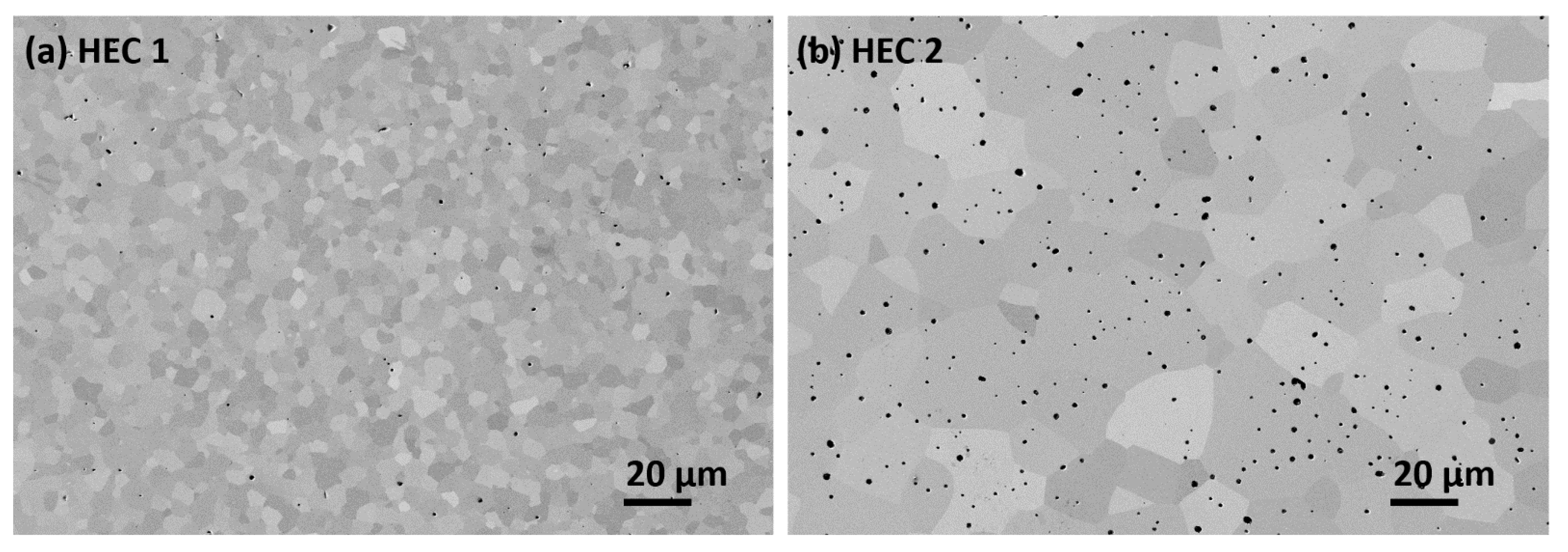

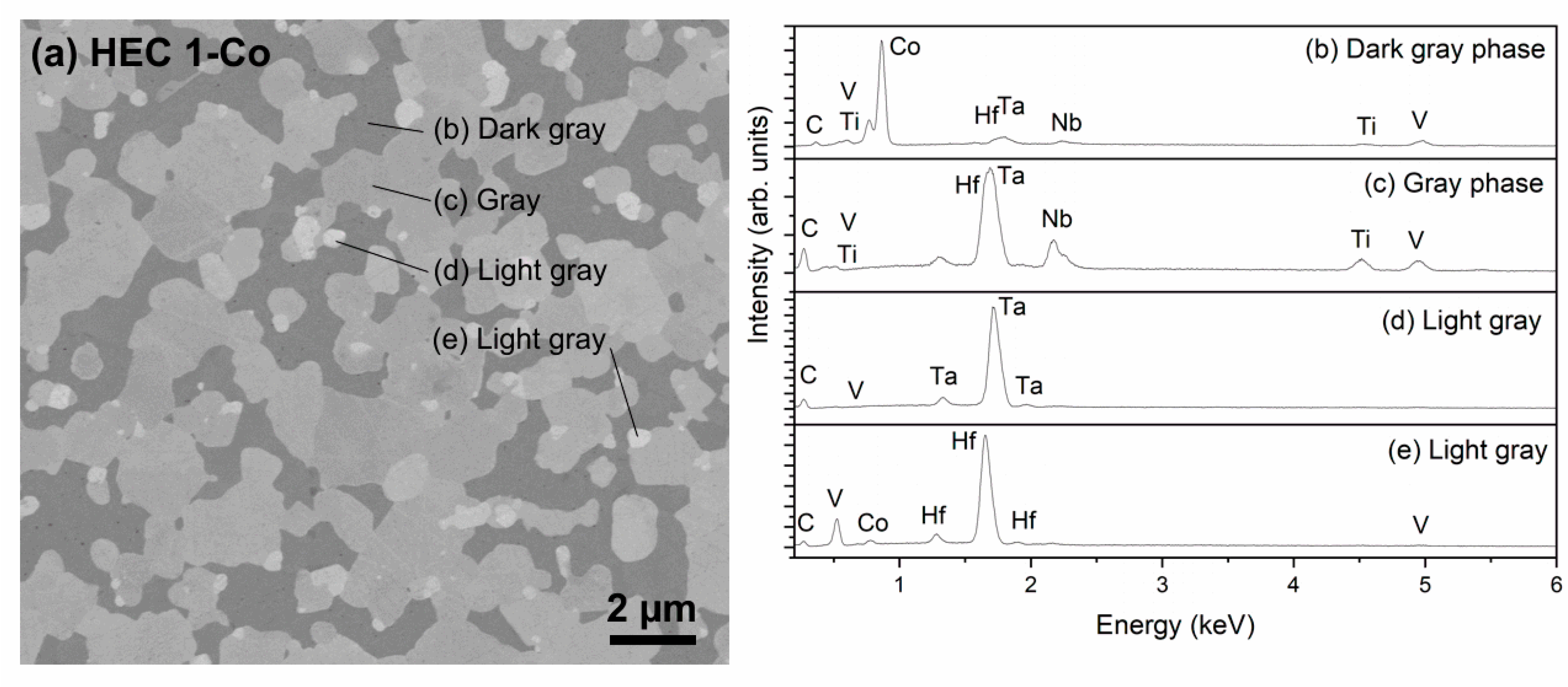
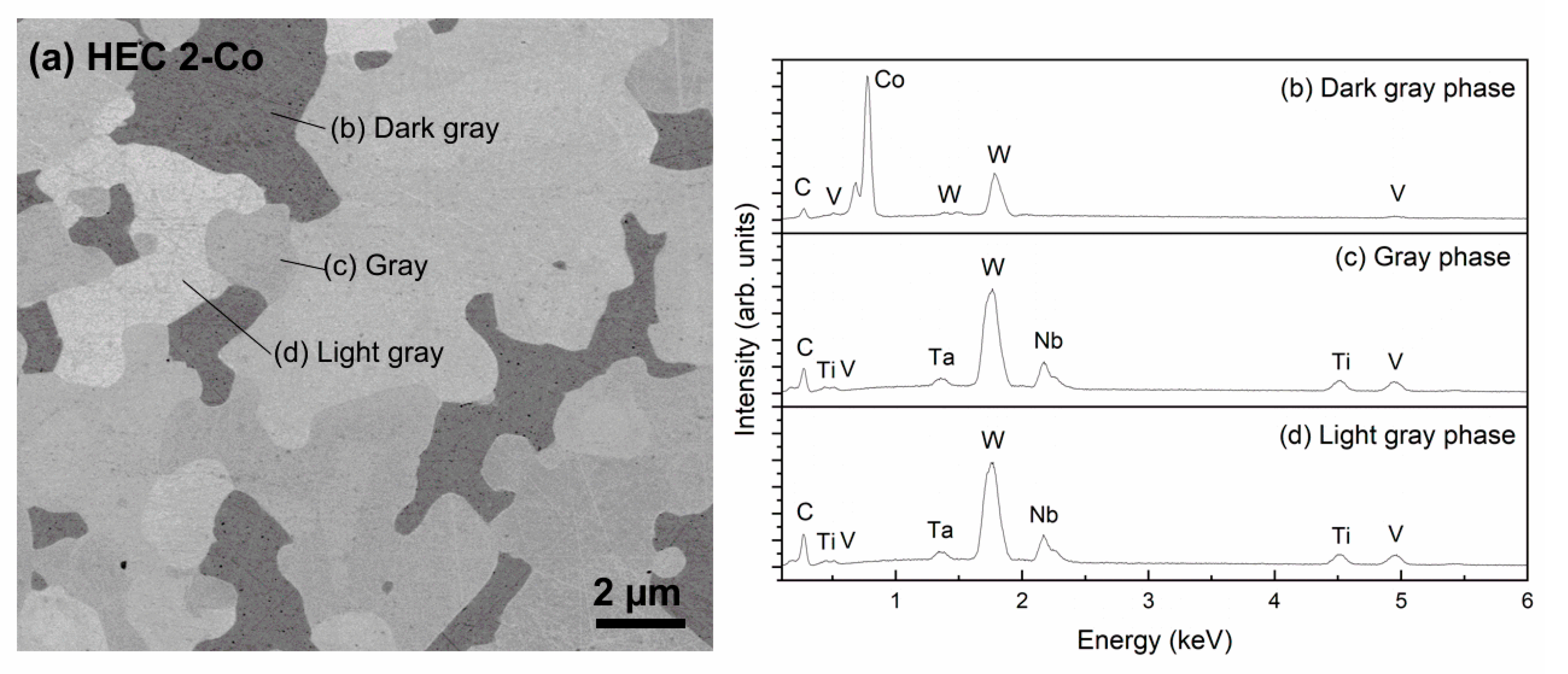
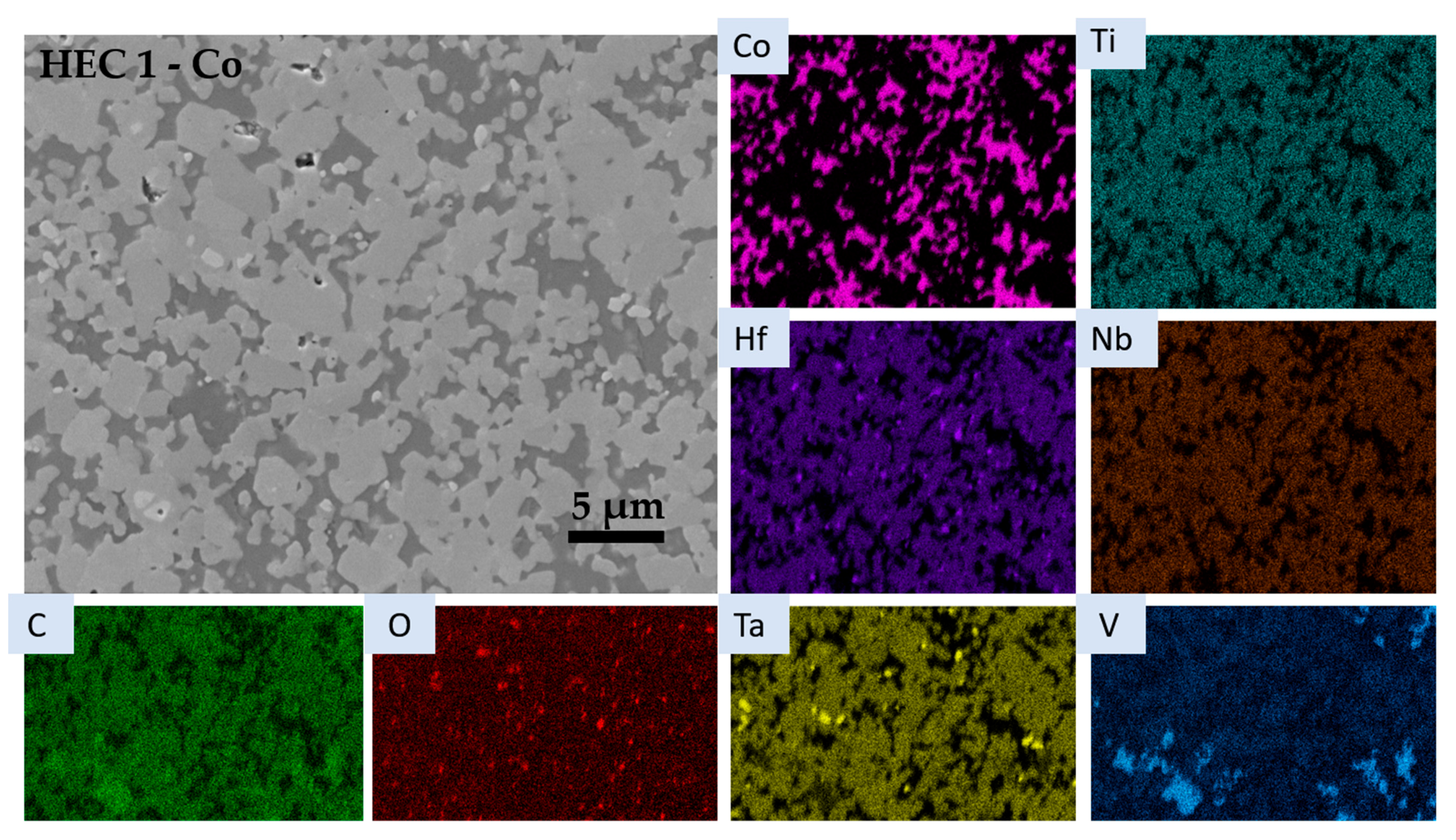
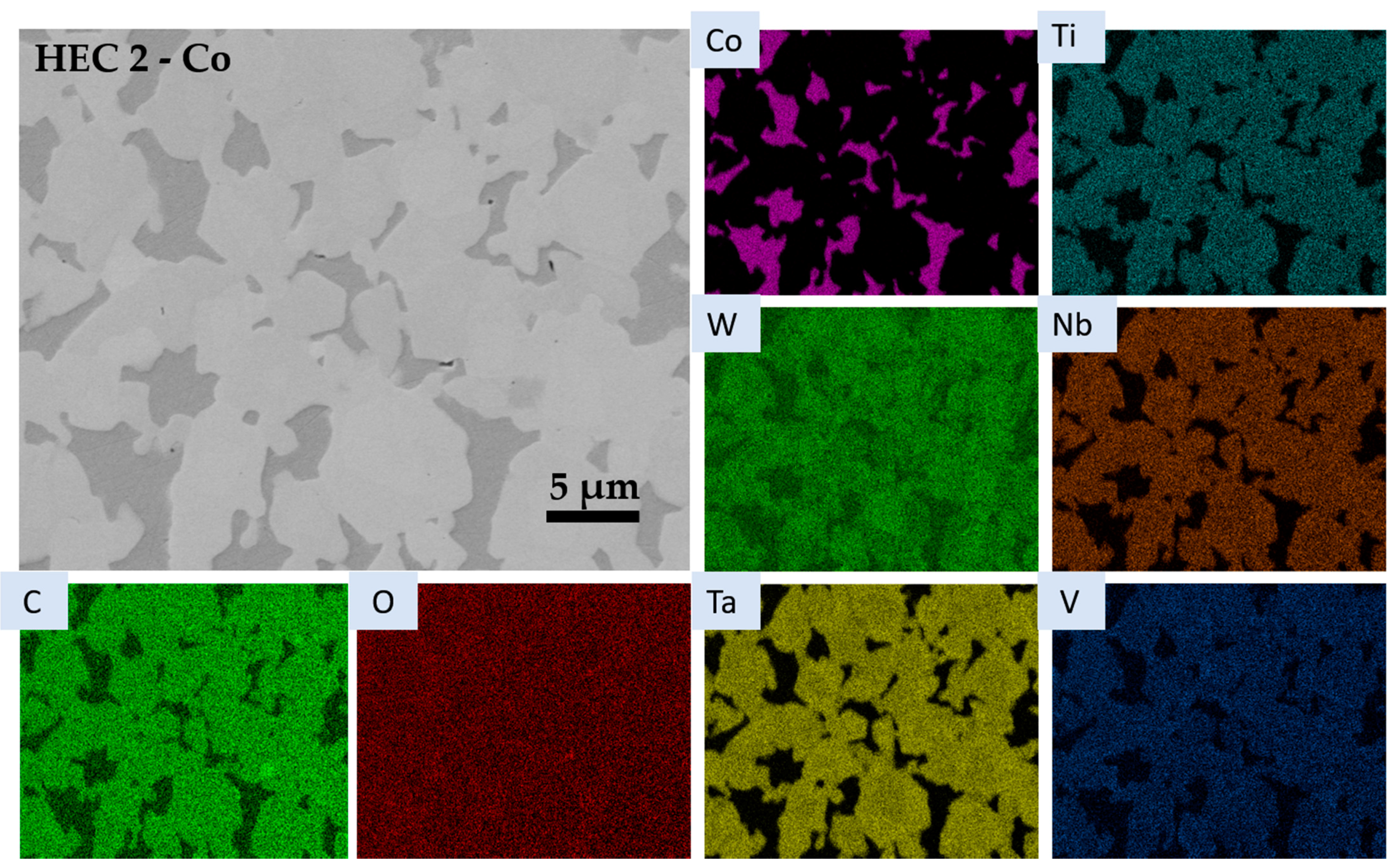
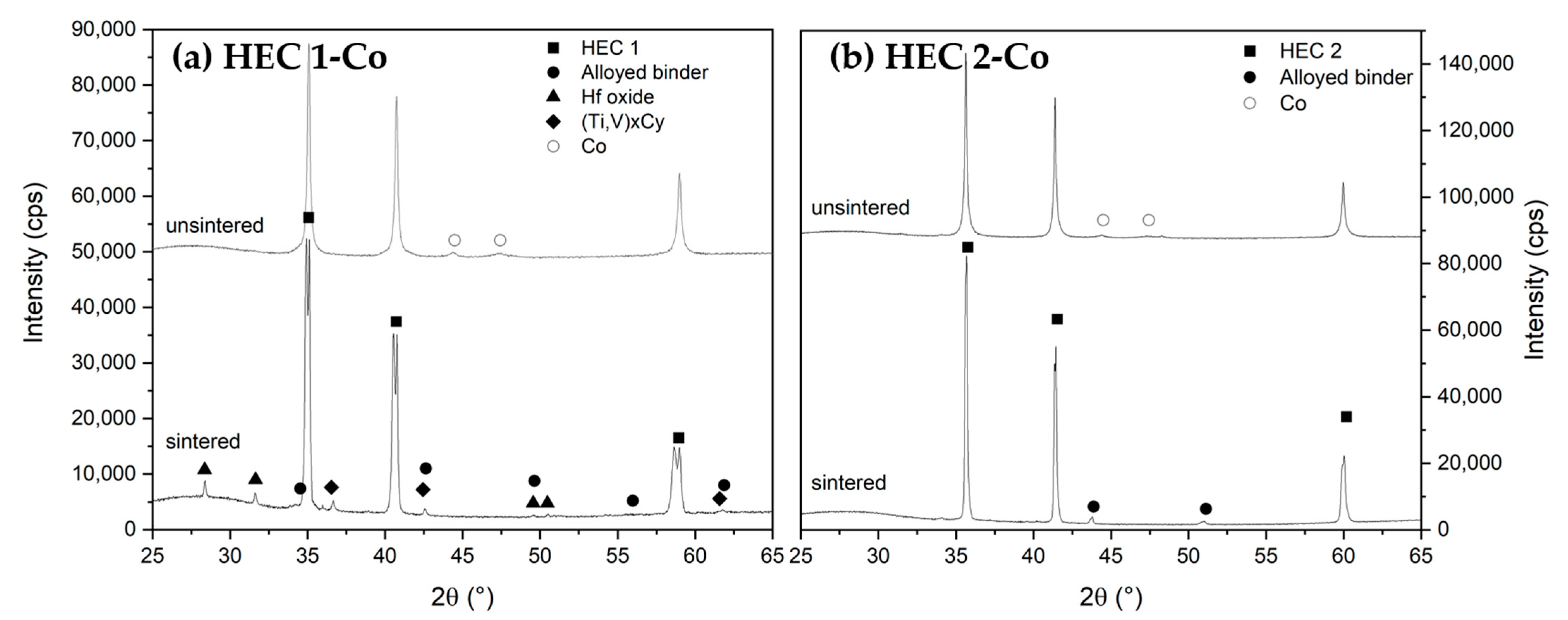
| HEC Samples | Compositions (wt. %) | |||||
|---|---|---|---|---|---|---|
| HfC | TaC | NbC | TiC | VC | WC | |
| HEC 1 | 31.2 | 31.6 | 17.2 | 9.8 | 10.3 | - |
| HEC 2 | - | 31.3 | 17.0 | 9.7 | 10.2 | 31.8 |
| Powders | Supplier | Particle Size dFSSS (µm) | Specific Surface Area BET (m2/g) | dBET (nm) | O2 Content (wt. %) |
|---|---|---|---|---|---|
| HfC | Sigma-Aldrich | 0.6 | 3.9 | 133 | 1.72 |
| TaC | H.C. Starck | 1.0 | 1.1 | 366 | 0.13 * |
| NbC | GTP | 1.2 | 1.2 | 639 | 0.25 * |
| TiC | H.C. Starck | 2.4 | 2.0 | 619 | 0.37 * |
| VC | H.C. Starck | 1.2 | 3.0 | 350 | 0.80 * |
| WC | H.C. Starck | 0.5 | 2.6 | 149 | 0.26 * |
| Hardmetal Samples | Sintering Conditions | Theoretical Density (g/cm3) | Archimedes Density (g/cm3) | Relative Density (%) |
|---|---|---|---|---|
| HEC 1-19.2 vol% Co | sinterHIP 1400 °C/100 bar Ar | 9.18 | 9.15 | 99.6 |
| HEC 2-19.2 vol% Co | 9.64 | 9.74 | 101.0 |
| Element | Ti | V | Nb | Hf | Ta |
|---|---|---|---|---|---|
| Main phase | |||||
| Mean value/at.% | 20.2 | 18.2 | 21.5 | 19.3 | 20.9 |
| Standard deviation | 0.9 | 3.2 | 1.2 | 1.1 | 1.9 |
| V- rich phase | |||||
| Mean value/at.% | 14.7 | 66.9 | 9.6 | 1.3 | 7.5 |
| Standard deviation | 0.5 | 2.4 | 0.9 | 0.3 | 1.0 |
| Element | Ti | V | Nb | Ta | W |
|---|---|---|---|---|---|
| Core | |||||
| Mean value/at.% | 18.3 | 19.5 | 21.2 | 20.4 | 20.7 |
| Standard deviation | 0.4 | 0.6 | 0.4 | 0.4 | 0.4 |
| Rim | |||||
| Mean value/at.% | 21.4 | 16.8 | 22.8 | 22.1 | 16.9 |
| Standard deviation | 1.1 | 0.8 | 0.7 | 1.0 | 2.0 |
| Samples | mS /µT·m3·kg−1 | mS /(% theo) | Hc /kA/m | Hardness | Fracture Toughness K1C/MPa·m1/2 | |
|---|---|---|---|---|---|---|
| /HV10 | GPa | |||||
| HEC 1-19.2 vol% Co | 30.0 | 70.0 | 5.6 | 1203 ± 15 | 11.80 | 8.5 ± 0.2 |
| HEC 2-19.2 vol% Co | 20.7 | 57.5 | 8.4 | 1432 ± 10 | 14.04 | 6.7 ± 0.2 |
| WC-19.2 vol% Co [43] | 19.9 | 85.0 | 19.9 | 1460 ± 15 | 14.32 | 14.3 ± 0.2 |
Publisher’s Note: MDPI stays neutral with regard to jurisdictional claims in published maps and institutional affiliations. |
© 2021 by the authors. Licensee MDPI, Basel, Switzerland. This article is an open access article distributed under the terms and conditions of the Creative Commons Attribution (CC BY) license (http://creativecommons.org/licenses/by/4.0/).
Share and Cite
Pötschke, J.; Dahal, M.; Vornberger, A.; Herrmann, M.; Michaelis, A. Production and Properties of High Entropy Carbide Based Hardmetals. Metals 2021, 11, 271. https://doi.org/10.3390/met11020271
Pötschke J, Dahal M, Vornberger A, Herrmann M, Michaelis A. Production and Properties of High Entropy Carbide Based Hardmetals. Metals. 2021; 11(2):271. https://doi.org/10.3390/met11020271
Chicago/Turabian StylePötschke, Johannes, Manisha Dahal, Anne Vornberger, Mathias Herrmann, and Alexander Michaelis. 2021. "Production and Properties of High Entropy Carbide Based Hardmetals" Metals 11, no. 2: 271. https://doi.org/10.3390/met11020271
APA StylePötschke, J., Dahal, M., Vornberger, A., Herrmann, M., & Michaelis, A. (2021). Production and Properties of High Entropy Carbide Based Hardmetals. Metals, 11(2), 271. https://doi.org/10.3390/met11020271







